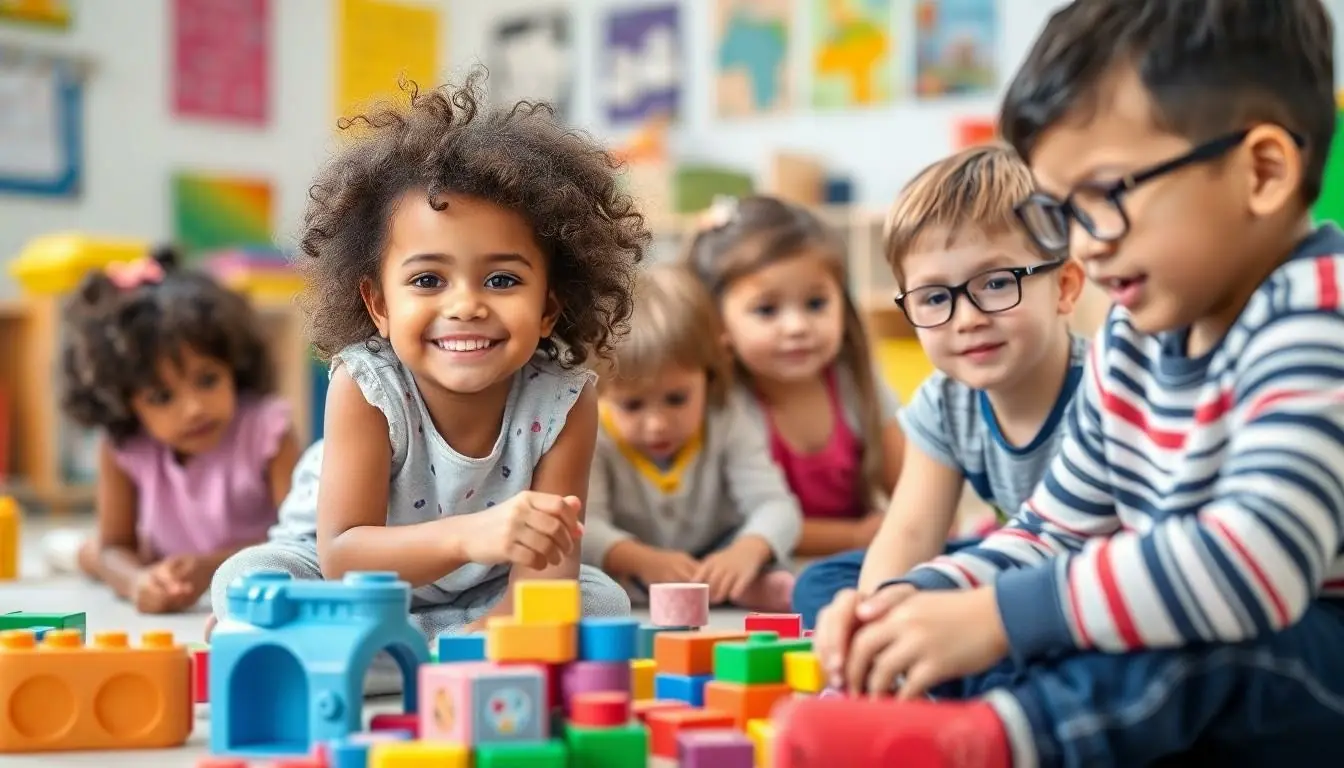Early childhood education and elementary education might sound like two siblings arguing over who gets the biggest slice of cake, but they each serve a unique purpose in a child’s development. One focuses on nurturing the tiny brains of toddlers while the other dives into the exciting world of learning for slightly bigger kids. It’s like comparing a cozy blanket fort to a full-fledged treehouse—both are essential for growth but offer different experiences.
Table of Contents
ToggleOverview of Early Childhood Education
Early childhood education serves as a crucial foundation for child development. This stage encompasses a range of educational programs geared toward children from birth to age eight.
Definition and Importance
Early childhood education refers to structured teaching and learning for young children, promoting cognitive, social, and emotional development. Programs often target children from infancy through preschool. Research indicates that quality early education improves academic performance, enhances social skills, and reduces the likelihood of behavioral issues later in life. National organizations emphasize the necessity of early educational experiences to ensure children enter elementary school ready to succeed.
Key Components
Several key components define early childhood education. Developmentally appropriate practices align with children’s age, culture, and individual needs. Play-based learning encourages exploration and creativity, fostering problem-solving skills. Engaging families in learning promotes strong home-school connections. Comprehensive curricula include literacy, math, and social-emotional skills, ensuring holistic development. Effective assessment methods guide educators in tailoring their approaches to meet each child’s unique developmental stage.
Overview of Elementary Education

Elementary education serves children typically from ages six to twelve. This stage builds on the foundation established during early childhood education, emphasizing essential academic and social skills.
Definition and Structure
Elementary education focuses on structured learning environments for young children. Typically, these programs include grades one through six. Classrooms promote a blend of teacher-led instruction and collaborative activities. Key elements include a standardized curriculum, statewide assessments, and guidelines set by educational authorities. Teachers often hold certification and specialize in specific age groups. Schools foster community involvement, encouraging parental participation in educational activities.
Curriculum and Learning Objectives
Curriculum in elementary education encompasses core subjects such as math, language arts, science, and social studies. Learning objectives aim to develop critical thinking skills, problem-solving abilities, and effective communication. Programs often integrate hands-on activities to engage students actively. Teachers design lessons to address different learning styles, ensuring each child comprehends the material. Additionally, social-emotional learning plays a vital role, helping students navigate interpersonal relationships and develop resilience.
Early Childhood Education vs Elementary Education
Early childhood education and elementary education serve different stages of child development, yet both play vital roles in a child’s learning journey.
Key Differences
Early childhood education caters to children from birth to age eight. This stage emphasizes developmental milestones through play and exploration. In contrast, elementary education targets children aged six to twelve, focusing on structured academic learning. The curriculum in early childhood settings prioritizes cognitive, social, and emotional development. Elementary programs center on core subjects like math, language arts, and science. Additionally, early childhood education emphasizes hands-on experiences while elementary education employs standardized assessments to track progress. Teachers in early childhood education often utilize flexible approaches, while elementary educators follow a more defined curriculum.
Similarities and Overlaps
Both educational stages share the goal of fostering holistic development in children. Early childhood education and elementary education prioritize social-emotional learning, helping students navigate relationships. Additionally, both promote family engagement to support children’s growth. Collaboration among educators, parents, and caregivers is essential in each context. Effective communication between these groups enhances the child’s educational experiences. Furthermore, both stages advocate for inclusive practices to accommodate diverse learning needs. Ultimately, both early childhood and elementary education lay a foundation for lifelong learning and success.
Benefits of Each Education Level
Early childhood education and elementary education provide unique advantages that significantly contribute to child development and learning. Understanding these benefits helps in appreciating their respective roles.
Impact on Child Development
Early childhood education fosters cognitive, social, and emotional growth. Engaging in structured activities promotes critical thinking and problem-solving skills. Social interactions during play help develop essential communication skills. Furthermore, children learn to regulate emotions and build relationships with peers. Elementary education reinforces these foundational skills, focusing on academic achievement. It introduces structured lessons in core subjects, enhancing knowledge retention. Students begin to explore subjects in greater depth, leading to increased curiosity and independent learning.
Long-term Educational Outcomes
Early childhood education correlates with improved academic performance in later years. Studies highlight that children who attend quality early programs often achieve higher test scores. They demonstrate better social skills and exhibit fewer behavioral issues. In elementary education, the focus shifts to building on early successes. Proficient skills in reading, writing, and math emerge through consistent, structured instruction. Standardized assessments track progress, helping educators identify areas for improvement. This comprehensive approach enhances students’ readiness for middle school and beyond, establishing a strong foundation for lifelong learning.
Both early childhood education and elementary education play vital roles in shaping a child’s future. Each stage contributes uniquely to development while sharing common goals of fostering holistic growth. Early childhood education lays the groundwork through play-based learning and social-emotional skills, setting the stage for academic success. Meanwhile, elementary education builds on this foundation with structured lessons and assessments, reinforcing knowledge and encouraging independent learning.
The collaboration between educators and families remains essential across both stages, ensuring that children’s diverse needs are met. Together, these educational phases create a seamless transition that enhances lifelong learning and success.





